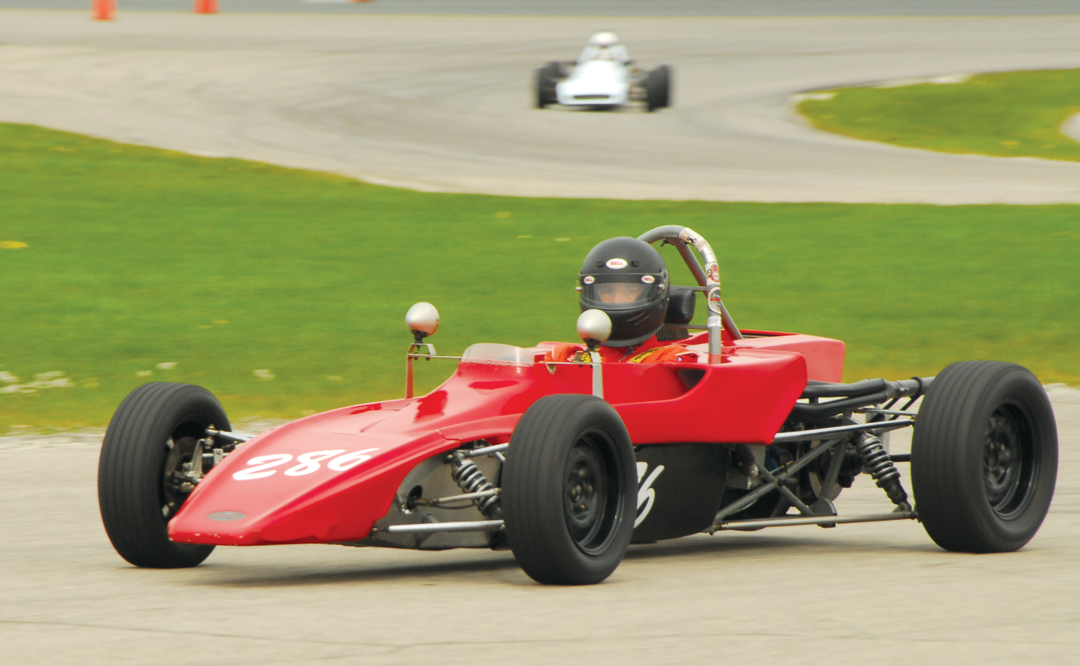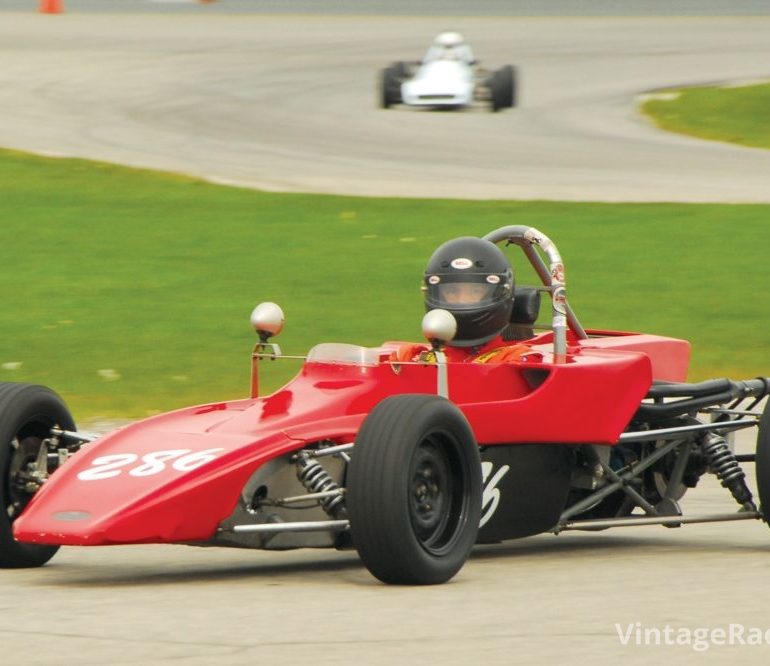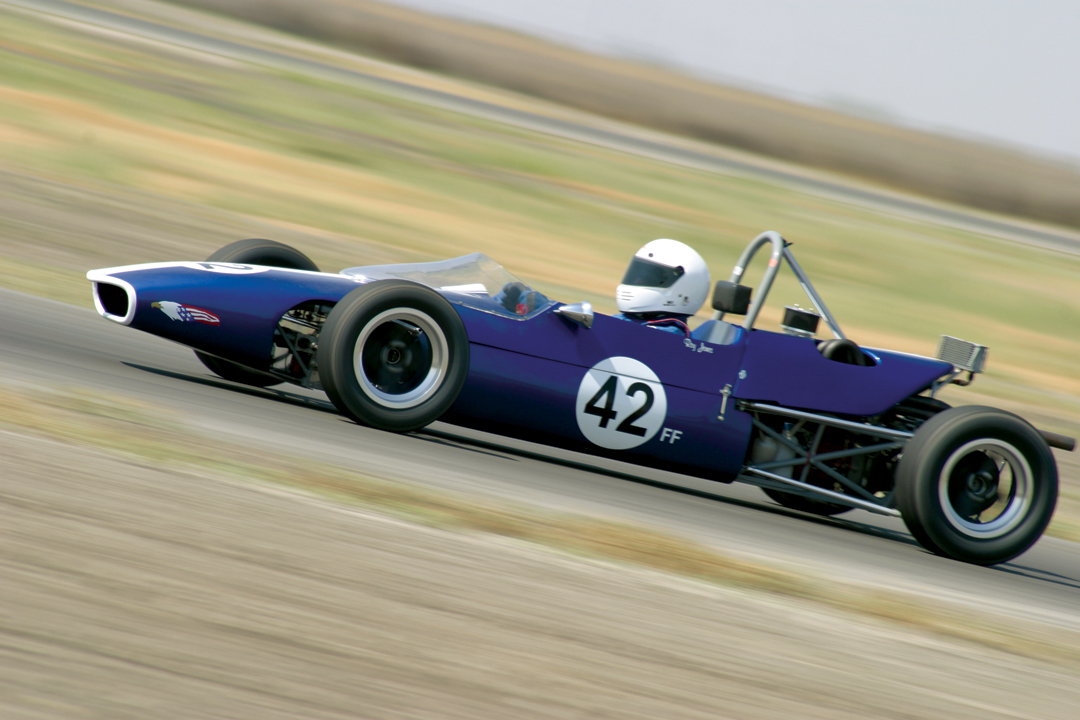Formula Ford was a racing series created around the idea that the best drivers would win if they were racing essentially identical cars. The idea for this low-budget formula was created by an Englishman named Geoffrey Clarke, who had a driver’s school called Motor Racing Stables based at the Brands Hatch Circuit. Clarke received support from Ford’s competition manager, Henry Taylor, and Ford’s director of public affairs, Walter Hayes. Ford supplied their 1600-cc Cortina GT engine (otherwise known as the “Kent” engine), as well as their financial backing and name. Lotus Components built a car based on the Lotus 31 Formula 3 car, calling it the Lotus 51 Formula Ford. Ironically, this early car had a Renault gearbox. They sold for the affordable price of just under £1,000, making racing in this series very affordable, since a Formula 3 car of the day cost more than £3,000. The Royal Automobile Club, Britain’s governing body, established a full set of racing regulations for Formula Ford, and the first official race was held at Brands Hatch on July 2, 1967. From 1967 to the present, Formula Ford has provided some very exciting racing in many different makes of racing cars, all around the world, as well as producing many great drivers and future champions, among them Emerson Fittipaldi, Jody Scheckter, Ayrton Senna Michael Andretti, and Tim Schenken. Today, historic Formula Ford is an entry-level racing category, and for the purposes of this guide, covers cars from 1967 to 1972. Keep in mind that the greatest single factor in determining the value of a Formula Ford is the quality and cost of its preparation.
| Make | Model | Level III | Level II | Level I |
| Alexis | 15 | $10,000 | $14,000 | $18,000 |
| 18, 22 | $10,000 | $14,000 | $18,000 | |
| Bobsy | $8,000 | $12,000 | $18,000 | |
| Caldwell | D9, D9B | $10,000 | $14,000 | $18,000 |
| Crossle | 16F | $8,000 | $14,000 | $18,000 |
| 20F | $8,000 | $15,000 | $20,000 | |
| Dulon | LD4, 4B, 4C | $7,000 | $10,000 | $16,000 |
| LD9 | $8,000 | $12,000 | $18,000 | |
| Elden | PH8 | $10,000 | $14,000 | $18,000 |
| PH10 | $10,000 | $16,000 | $20,000 | |
| Ginetta | G-18 | $8,000 | $12,000 | $18,000 |
| Hawke | DL2, 2A, 2B | $10,000 | $14,000 | $20,000 |
| DL9, 9A | $12,000 | $16,000 | $22,000 | |
| LeGrand | Mk 10 | $8,000 | $12,000 | $17,000 |
| Lola | T200 | $10,000 | $16,000 | $20,000 |
| T202 | $10,000 | $18,000 | $22,000 | |
| T204 | $12,000 | $18,000 | $24,000 | |
| Lotus | 51 A,B,C | $16,000 | $22,000 | $26,000 |
| 61M, MX | $12,000 | $16,000 | $22,000 | |
| 69 | $26,000 | $32,000 | $38,000 | |
| Macon | MR 7B | $8,000 | $12,000 | $17,000 |
| MR8, 8B | $8,000 | $12,000 | $17,000 | |
| March | 709, 719, 729 | $14,000 | $18,000 | $22,000 |
| Merlyn | MK11, 11A | $18,000 | $22,000 | $26,000 |
| MK17, 17A | $14,000 | $17,000 | $22,000 | |
| MK20, 20A | $14,000 | $18,000 | $24,000 | |
| Royale | RP2 | $8,000 | $14,000 | $18,000 |
| RP3, 3A | $10,000 | $16,000 | $21,000 | |
| Tecno | FF | $10,000 | $15,000 | $20,000 |
| Titan | MK 6,6A,6B,6C | $16,000 | $22,000 | $26,000 |
| Winkelman | WDF1,2,3,4 | $10,000 | $15,000 | $20,000 |
1970 Winkelmann WDF2
Noted English driver Hugh P.K. Dibley commissioned former Brabham and Lola designer Lem Wimhurst to design a twin-cam powered Formula B car in 1967. It was called the Palliser, taken from the “P” in Mr. Dibley’s initials. Next to come would be a series of Formula Ford models beginning in 1969. These cars were sold and raced successfully in the USA by Northern California-based Bob Winklemann, who gave these cars his own name so the Palliser became known as the Winklemann. Wilmhurst’s first Formula Ford design, the WDF1, was a good one, and ran very competitively in the 1969 and 1970 seasons. It was known for its large cockpit. It evolved into the WDF2 and WDF3, which were raced into 1971 and 1972. Dibley sold his interest in the company in 1972 to Bob Winkelmann, who in turn sold the company in 1973 to Mark Konig and Ian Heath, owners of the Nomad Company. So, the Palliser became the Winklemann and the Winklemann became the Nomad or even the other way around. Such was the life of an entrepreneur racer in the good old days pre bailouts and subsidies.
1972 Royale

Robert King, a London-based car salesman and mechanic, started a racecar preparation shop out of his garage at home called Racing Preparations. As his reputation and business blossomed, he moved to a proper workshop in London. With the new Formula Ford category growing, he contracted with Surtees designer Bob Marston to build a Formula Ford chassis for him. The RP1, as it was called because of King’s surname and his Park Royal address, was the birth of another racecar manufacturer “Royale.” Royale sold quite a few cars to the USA where they were successful, and later branched out into Formula B, Super Vee and sports racing cars. With new designer Rory Byrne on board in 1972, some very successful cars were designed. Geoff Lees won the Formula Ford Festival in a Royale in 1975. Bob Marston would move on to Lola Cars, and Rory Byrne to Toleman. So it was that Formula Ford became the starting point for many great racers and designers as well.
Criteria Used For Assessing Valuations for this Guide:
- Degree of Originality
- Overall Condition, Restoration
- Technology, Design, Coachbuilder
- Production Numbers/Rarity
- Competition History
- Ownership History, Documentation
- Modern Event Eligibility
Regional Variances
The prices stated in this guide are based on U.S. values. The values of historic racing cars can vary as much as 25%-35% in other countries, depending on local market appeal, currency rates, import duties, and VAT. Most of the time, we are able to document known sales or closed escrows, as they say in real estate. When this is not possible, a logical estimate of the car’s value is given, based on its sales history and relationship to cars of its type.
The prices stated in this guide are based on U.S. values. The values of historic racing cars can vary as much as 25%-35% in other countries, depending on local market appeal, currency rates, import duties, and VAT.
LEVEL |
VALUATION CATEGORIES |
|---|---|
I |
The best combination of all criteria. |
II |
Satisfies mid-range of criteria. |
III |
In need of restoration. Meets only a few points of criteria |





